
William Marshall's engineering works from where Marshall steam engines, threshing machines and tractors were exported all over the world.
Marshalls Yard,
Beaumont Street,
Gainsborough,
Lincs
In 1848 the local millwright’s business of the late William Garland in Back St., Gainsborough, Lincs., was purchased by William Marshall, when he returned to his hometown of Gainsborough from Manchester, with his second wife and two sons. He later bought the land in Beaumont Street, on which the Britannia Ironworks was to be constructed, in 1855. His son James became a partner in 1849 and the name changed to William Marshall & Son. In 1853 his other son Henry Dickenson Marshall also joined the business. William Marshall died in 1861. His two sons continued to run the business which became a limited company in 1862. By the end of 1885 the buildings (made from bricks manufactured on site) covered 11.5 acres on a 16 acre site, and employed 1900 men.
The company was primarily engaged in the manufacture of agricultural machinery, building steam engines from its early days. Products included steam powered engines, threshing machines and agricultural machinery until the early 20th century. Marshall’s first internal combustion powered tractor, a petrol-paraffin fuelled machine, was developed as early as 1906 and became known as the ‘Colonial’ tractor, as the large machines were mainly sold overseas, in the Colonies. Production ceased with the outbreak of WW1.
During WWl Marshall’s traditional markets began to decline, but the workforce grew to 5000 to cope with the production of munitions. In 1917 a new works was built in Lea Road nearby, to manufacture aircraft. This became known as Carr House Works. Over the course of hostilities, the company built 150 Bristol F2B two-seat biplane fighters. When complete, they were dismantled and towed to West Common, Lincoln, which had become a test flying ground for aircraft from Marshalls, and other (Lincoln based) companies. Some Marshall’s aircraft were also flown from Layne’s Field, Gainsborough. Marshalls also built Mk IX supply tanks The Mk IX supply tank is a bit like it's maker, often overlooked. The need to move stores and soldiers around the battlefield in relative safety was vital and Marshalls Mk IX was exactly what was needed. The tank must have been a well made and reliable platform as one was fitted out as an experimental, armoured battlefield ambulance and another was altered to become the worlds first fully amphibious tank! Only 34 Mk IX tanks were ever built and today only one survives. It can be seen at the Bovington Tank Museum in Dorset and inside on the back of the hull is the original 1918 Marshall Sons and Co makers plaque.
At the end of WW1, Marshalls returned to manufacturing traction engines, steam rollers and steam tractors. In 1928 they started to develop a full diesel tractor based on the semi-diesel German Lanz Bulldog design. In 1930 the Model E 15/30 diesel engine tractor was produced, it had a single cylinder two-stroke engine, bore 8” with 10.5” stroke. An improved version known as the 18/30 was produced from 1932 until 1934. In 1935 the 12/20 was introduced, which became the Model M in 1938.
In 1934 a Receiver was appointed to run the Company and to find a new owner. Thomas W. Ward became the new owners in 1935 and in 1936, a new company was formed – Marshall, Sons & Co (Successors) Ltd.
Few tractors were produced between 1938 – 1945, but the company is well known for secretly manufacturing midget submarines. This important work has been remembered by the placing of a ‘blue plaque’ on the present day site by the Submariners Association reading: ‘To commemorate the building of HM Submarine X24 (HMS Expeditious) on this site in 1943’ with further detail of her crews and successful operations. The same submarine was also remembered by a plaque carried by a Class 153 diesel unit of East Midlands Trains/Railway. The sole surviving example of a Marshall’s built X class submarine, X24 itself, is in the Royal Navy Submarine Museum at Gosport, Hants. They also built two XE class midget submarines, XE11 & 12.
During WW2 an updated Model M tractor was further developed and launched in 1945 as the well known Field Marshall. In 1947 Thomas W. Ward also bought John Fowler & Co., Leeds and a tracked version of the Field Marshall, the Fowler VF, was produced.
The Field Marshall was manufactured up until 1952, when it was replaced by the 6 cylinder MP6 wheeled tractor and the Track Marshall crawler tractor. In 1975 Thomas W. Ward put Marshall-Fowler up for sale, which was bought by Aveling-Barford, part of British Leyland’s Special products Division. The new company became Aveling-Marshall Ltd.
In 1979 British Leyland shut down Aveling-Marshall, with the Track Marshall division being sold to Lincolnshire businessman Charles Nickerson, who set up his business in the South Works, now a Tesco supermarket. In 1982 the company bought the rights to the Leyland tractor range, with production continuing at Gainsborough, and sold under the Marshall name. Although initially successful the venture failed to generate enough capital to fund development of new models and market share began to be lost.
In 1985 the receivers were again called in. Hubert Flatters, a former sales director of Marshalls, acquired Marshall Ltd from the receivers and production of crawler tractors was resumed on a limited scale on February 3rd 1986, with the company trading as Track-Marshall of Gainsborough Ltd. Eventually the receiver sold the wheeled tractor side of the business to Bentall Simplex who established an assembly plant at Scunthorpe, trading as Marshall Tractors Ltd.
Some of the Britannia Works frontage is a Grade ll listed building, but much of the site has been redeveloped as a mixed retail, office and restaurant space, opening in 2007.
The original statue of Britannia still sits above the entrance to the complex and some of the original walling and ironwork has been incorporated into the ‘faithfully replicated’ façade, which may be a pale shadow of the original but gives an impression of the scale of the previous North Works.
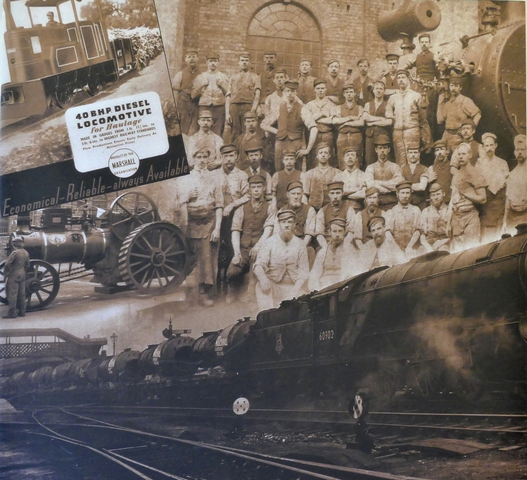
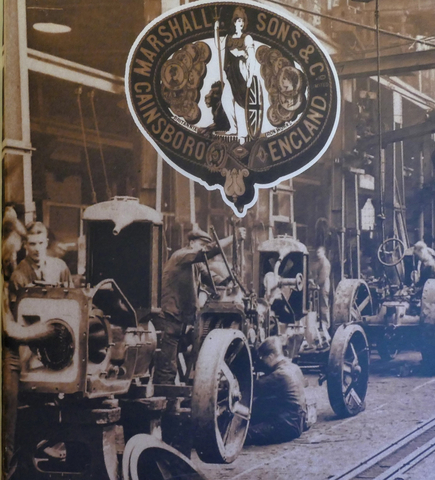
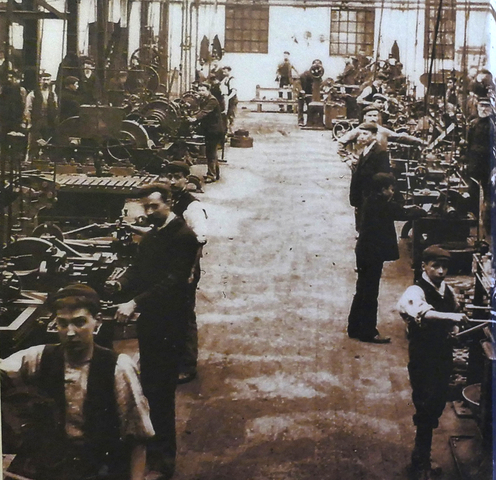
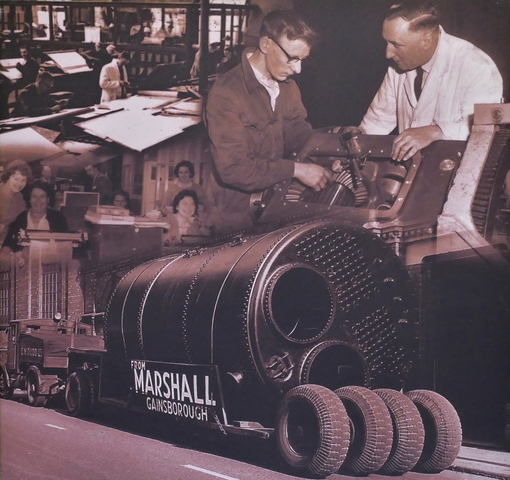
A section of a steam crane from the Works was saved and has been sited over the entrance used by motorists visiting the site.
The Red Wheel heritage plaque was unveiled on 8th September 2023 by Sir Edward Leigh MP with Jerry Swift - Deputy Chairman, NTT.
L-R: Melissa Cutforth, Assistant Manager, Marshalls Yard; Sir Edward Leigh MP; Jerry Swift; Wendy Osgodby, Senior Growth Strategy & Projects Officer, West LIndsey District Council.
Text from Brian Ward, Richard Pullen, Marshall Club and Gainsborough Heritage Association, with thanks
By road: Off A631 or A158 and follow signs to town centre.
Direct navigation links:
what3words address: ///typed.lends.snaps
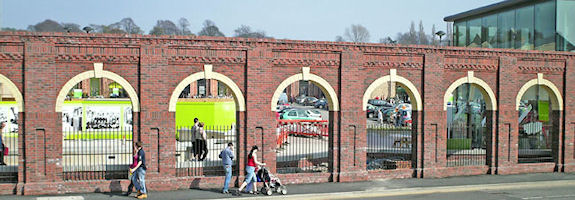
Anderson, Peter, Marshall Diesel Tractors 1930-1957, Old Pond Publishing Ltd, ISBN-10: 1905523882 (2008)
Condie, Alan, T., Marshall Single Cylinder Diesel Tractors 1930-1957 15/30 to Series 3a, Vintage Tractor Publications, ASIN: B001XQU7T4 (1980)
Lane, Michael R., The Story of Britannia Iron Works: William Marshall and Co., Gainsborough, 1848-1993, Quiller Press, ISBN-10: 1870948858 (1993)
(Various), British Tractor Story: Marshall, Leyland and Nuffield, A.T.Condie Publications, ISBN-10: 0907742572 (1987)
Powerhouse Museum - Marshall Britannia portable steam engine, 1914
West, Anthony - History of the Field Marshall Tractor